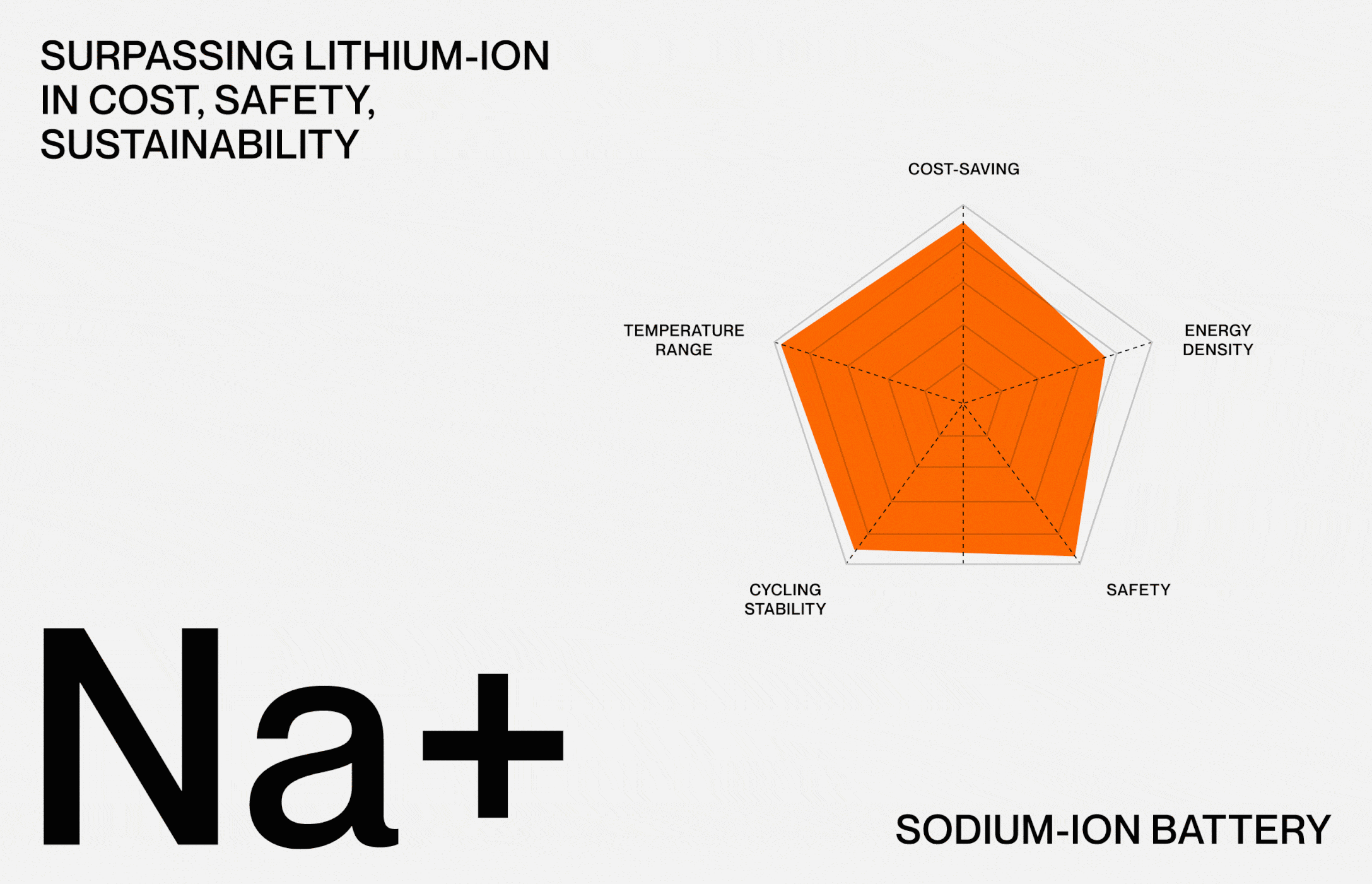Sign up for daily news updates from CleanTechnica on email. Or follow us on Google News!
Grid-scale battery storage is crucial to the success of the transition to renewable energy. Wind and solar are marvelous technologies, but their output tends to vary depending on wind speeds, cloud cover, and other factors. Until recently, grid-scale storage batteries have relied on lithium-ion batteries — NMC to begin with, but LFP more recently. Peak Energy believes it has the ability to manufacture sodium-ion batteries that outperform both at half the cost.
On its website, Peak Energy says it is “the first American venture to advance globally proven sodium-ion battery systems as the storage standard for the new era of renewable energy on a resilient grid.” This week, the company emerged from stealth mode to announce a $10 million funding round led by Eclipse, with significant participation from strategic partner TDK Ventures. In a press release, the company says it is on a mission to accelerate grid decarbonization while drastically lowering the cost of energy storage and establishing the US as a global leader in the sodium-ion market.
Peak Energy was founded by three people with vast experience in the field. CEO Landon Mossburg previously worked at Northvolt and Tesla. COO Cameron Dales was the general manager of Enovix and board member Greg Reichow has also been a production engineer at Tesla and vice president of operations at SunPower.
Peak Energy & Renewables
Renewables are on track to become the largest source of global electricity generation by early 2025, but without affordable, reliable storage for the grid, the US cannot reap the full benefits of these inexpensive and clean, but intermittent sources of energy, the company says. While lithium ion has been the default battery solution, its high cost structure, supply chain insecurity, safety concerns, and large carbon footprint make it less than ideal for grid scale storage.
Sodium ion is rapidly becoming a proven battery chemistry, offering clean and secure storage at a significantly lower cost and carbon footprint. With a clear opportunity to ensure affordable energy, Peak Energy is moving fast to industrialize sodium-ion technology with a goal of lowering energy storage costs by up to 50%.
“Sodium-ion is the key to unlocking the potential of renewable energy and will finally enable power providers to fully decarbonize the grid,” said CEO Landon Mossburg. “The timing could not be better to build a company in this space, and we already have momentum with key customers and partners like Doral Energy. There is a massive opportunity for the United States to emerge as the global leader in sodium ion production and deployment, and Peak Energy is at the forefront of that effort.”

Image courtesy of Peak Energy
Due to its high energy density, lithium-ion has become the dominant battery chemistry across several massive and growing market segments, including mobile devices and electric vehicles, driving unprecedented lithium demand and pricing volatility. Meanwhile, most of the world’s lithium extraction and battery manufacturing exists outside of the US, adding levels of geopolitical, supply chain and sourcing complexities that impact the cost and availability of energy storage for Independent Power Producers and electric utilities.
With the U.S. having already ceded leadership on lithium-ion innovation and investment to other countries, it’s critical that it invests in and takes the lead in developing the battery chemistries of tomorrow. Sodium-ion, a stable and proven battery chemistry that offers cost, sourcing, safety, and emission advantages over lithium-ion, is one such chemistry.
Abundant Materials
With wide-scale abundance of source materials and a chemistry that produces less carbon emissions and makes it less prone to fires and other safety concerns, sodium-ion is a better alternative to lithium-ion for stationary applications such as grid-scale storage. It is a technology that can help the US take a leadership position in global battery manufacturing.
“The cost of energy is directly correlated to human progress — improving health outcomes, solving food scarcity and reducing poverty all depend on access to low-cost energy,” said Greg Reichow. “For the U.S. to become a global leader in renewable energy, we cannot afford to place the wrong bets. We must invest in the ventures and the people who have demonstrated they can get to scale quickly, and Peak’s founding team brings an unprecedented level of credibility and experience to Peak’s mission.”
“Peak’s founders have identified a cost effective, safe solution with a deployment strategy that enables quick execution and sustainable growth for sodium-ion battery innovation,” said Anil Achyuta, Managing Director at TDK Ventures. “Peak Energy has an opportunity to dominate this market, and we’re looking forward to partnering with the entire team to accelerate and expand access to affordable, clean storage solutions.”
Beginning in 2025, Peak Energy will start deploying its sodium-ion systems while simultaneously building a domestic, giga-scale battery factory that is scheduled to begin operations in 2026. The initial round of financing will allow the team to accelerate product development, lay the groundwork for building out manufacturing in the U.S. and acquire strategic talent to push the mission forward.
Peak Energy Is Doing Things Differently
In an interview with CNBC this week, Cameron Dales said, “A normal Silicon Valley startup is 10 years in the lab, come up with a better mousetrap and go to market. We’re completely the opposite.” Peak Energy hopes to partner with a technology company (yet to be selected) that is already an expert in battery technology but does not have the capacity to scale manufacturing.
“In the battery market it turns out the rarest commodity is not the technology — there are many excellent ideas out there at academic labs and startups — but rather the ability to scale to manufacturing,” Mossburg added. “The difficulty of manufacturing scale up is one of the reasons you see so many ‘breakthrough battery technology’ announcements but very, very few companies who actually reach market. We’re running a playbook which I and the rest of the executive team initially demonstrated and deployed at Northvolt.”
The Swedish battery company also started with a small seed round of funding and ended up raising more than $9 billion in a combination of equity and debt. Mossburg was involved with securing all of that financing except for the most recent $1.2 billion announced in August. Dales and Mossburg both sound like people who have spent plenty of time in the company of Elon Musk, the acknowledged master of scaling up new technologies.
“The number one issue we face as it relates to expanding renewable energy sources is storage,” Reichow told CNBC. “This problem must be solved but the existing approaches using lithium-ion and other technologies are not yet at a price point that enables the kind of scaling that society needs across sectors.”
Demand for grid-scale storage will continue to grow. The US Energy Information Administration has projected that battery storage capacity will grow from 9 gigawatts in 2022 to 49 gigawatts in 2030 and then to 247 gigawatts in 2050. That’s a baseline projection that includes the Inflation Reduction Act and assumes no additional changes in U.S. policy throughout the projection period.
“Weight, and therefore energy density, is much less important in a stationary storage system. The fact that these batteries are less energy dense isn’t really a big consideration for this application,” Reichow told CNBC. “A much more important consideration is the cost per unit energy that you’re able to store and that is where sodium-ion, we believe, will have a big advantage over lithium-ion in the future.”
Have a tip for CleanTechnica? Want to advertise? Want to suggest a guest for our CleanTech Talk podcast? Contact us here.
EV Obsession Daily!
I don’t like paywalls. You don’t like paywalls. Who likes paywalls? Here at CleanTechnica, we implemented a limited paywall for a while, but it always felt wrong — and it was always tough to decide what we should put behind there. In theory, your most exclusive and best content goes behind a paywall. But then fewer people read it!! So, we’ve decided to completely nix paywalls here at CleanTechnica. But…
Thank you!
Tesla Sales in 2023, 2024, and 2030
CleanTechnica uses affiliate links. See our policy here.




